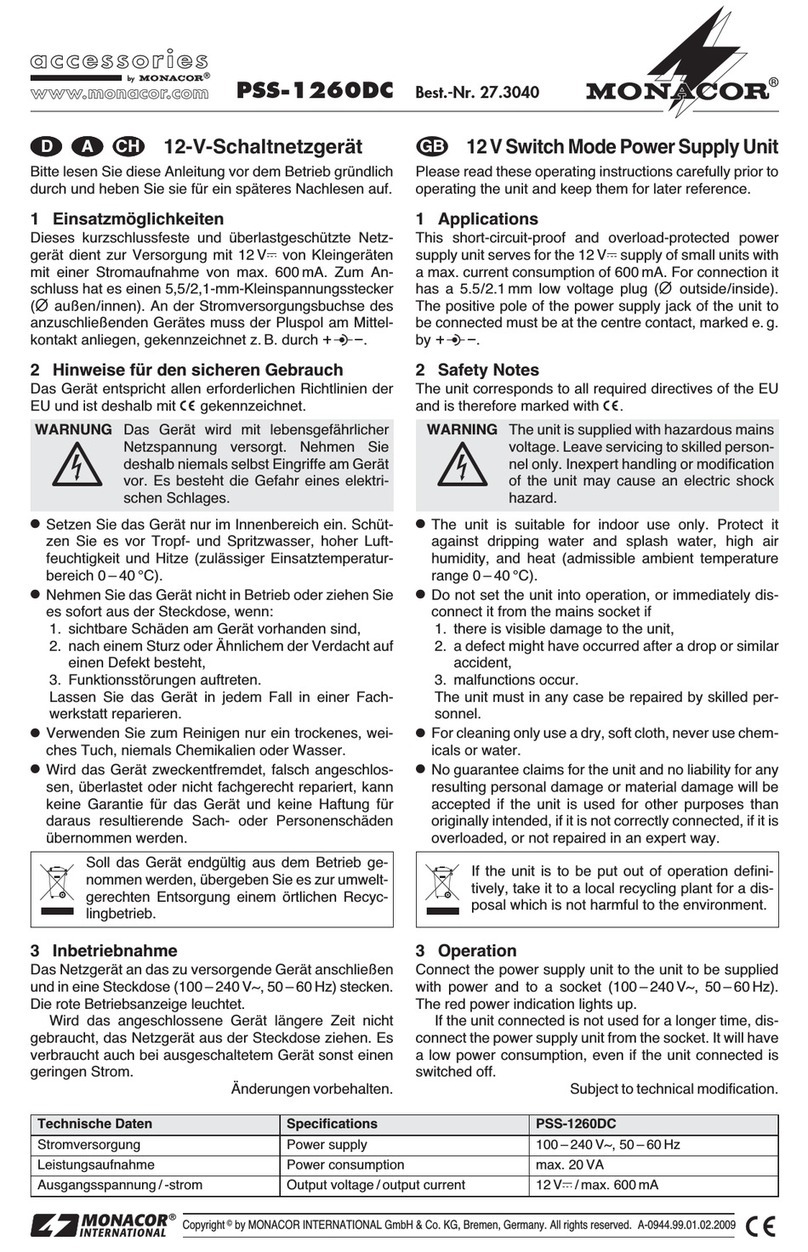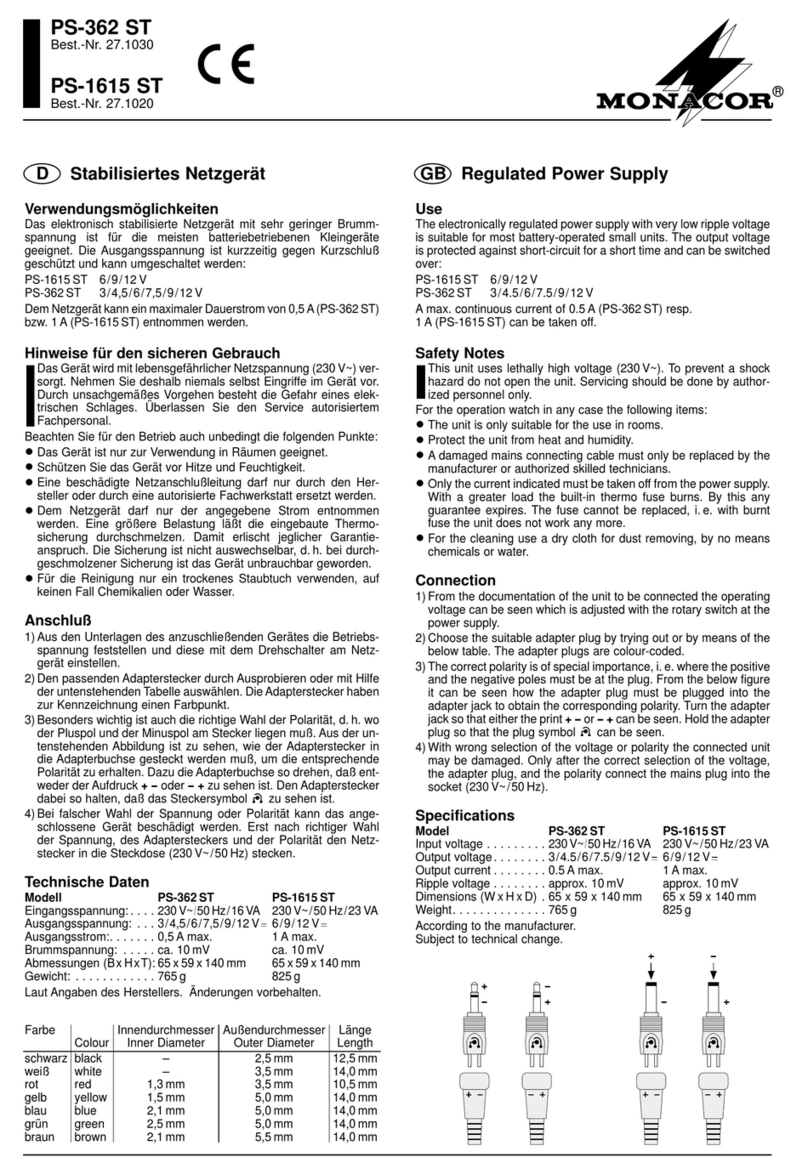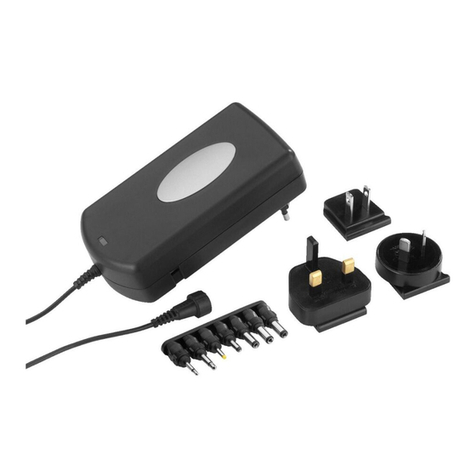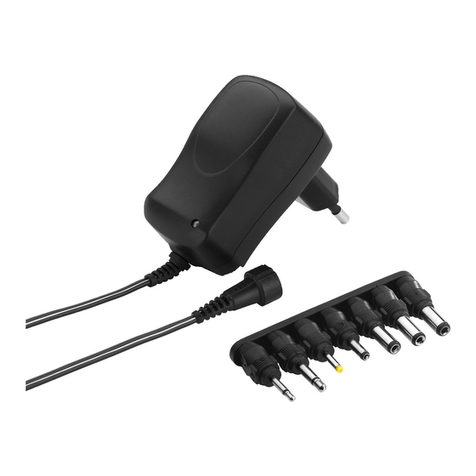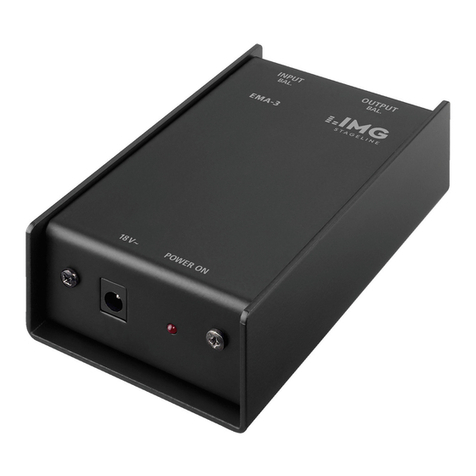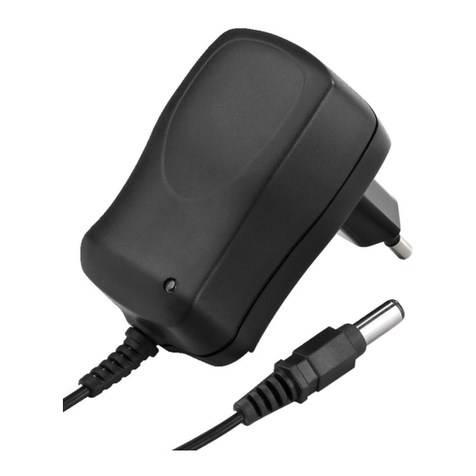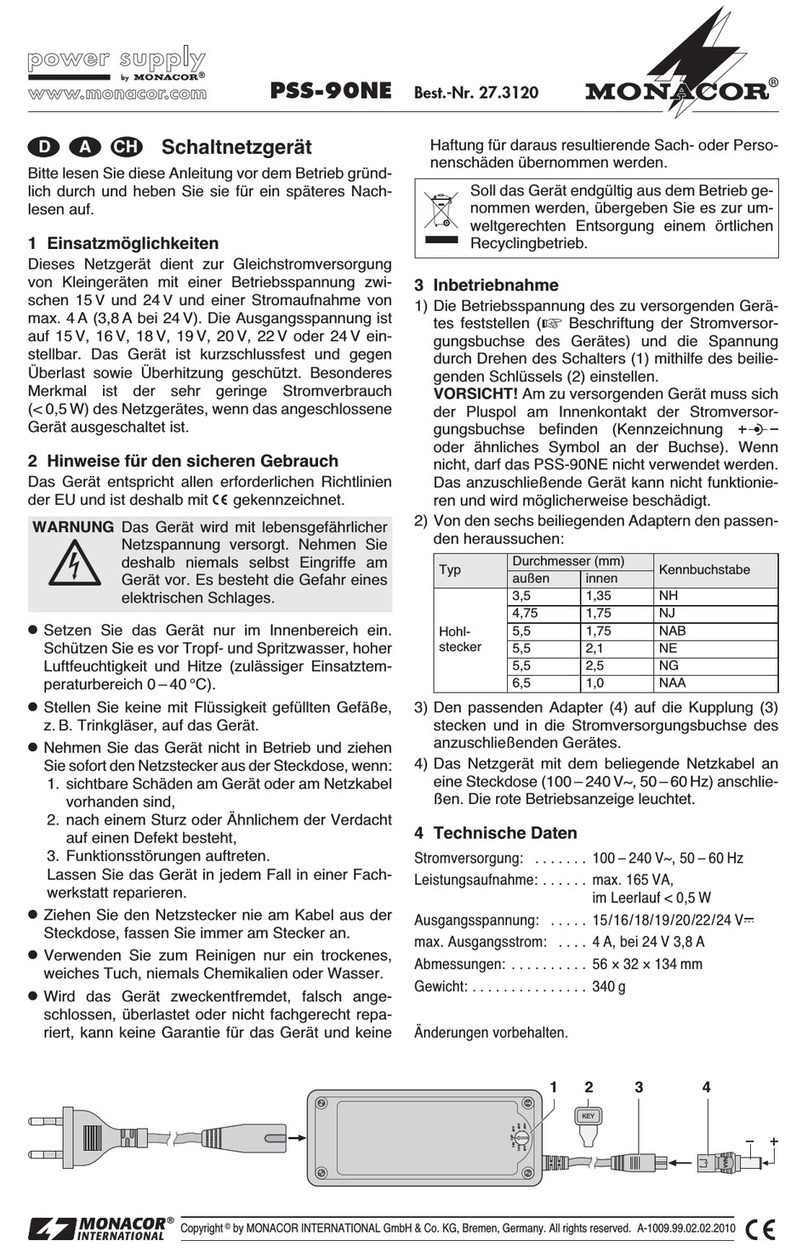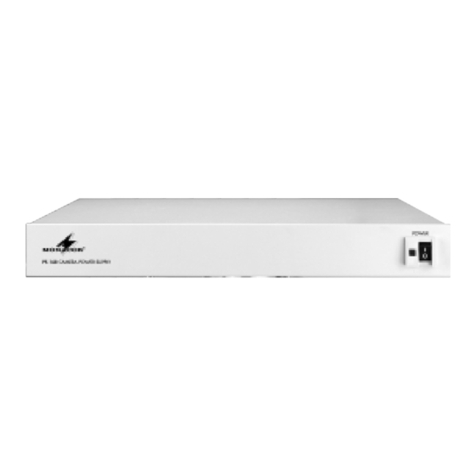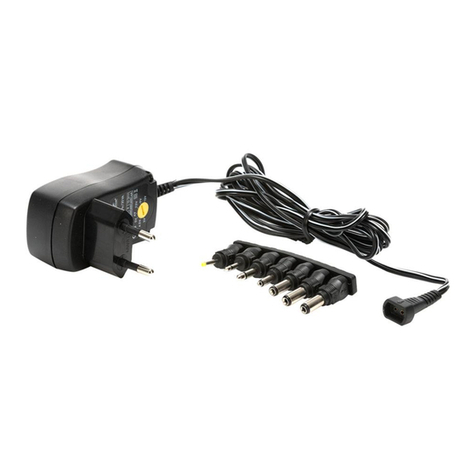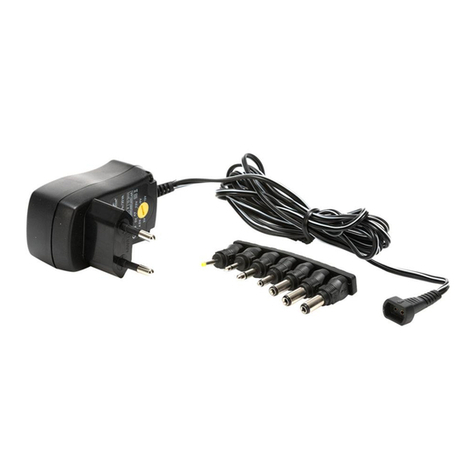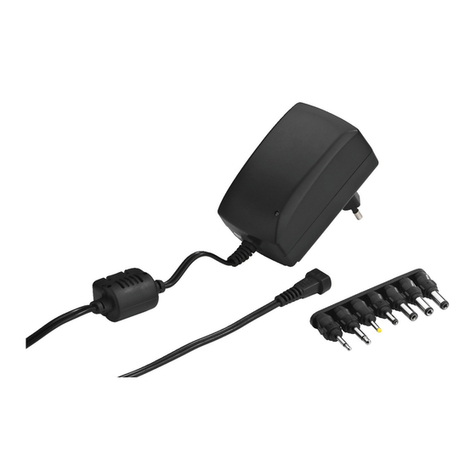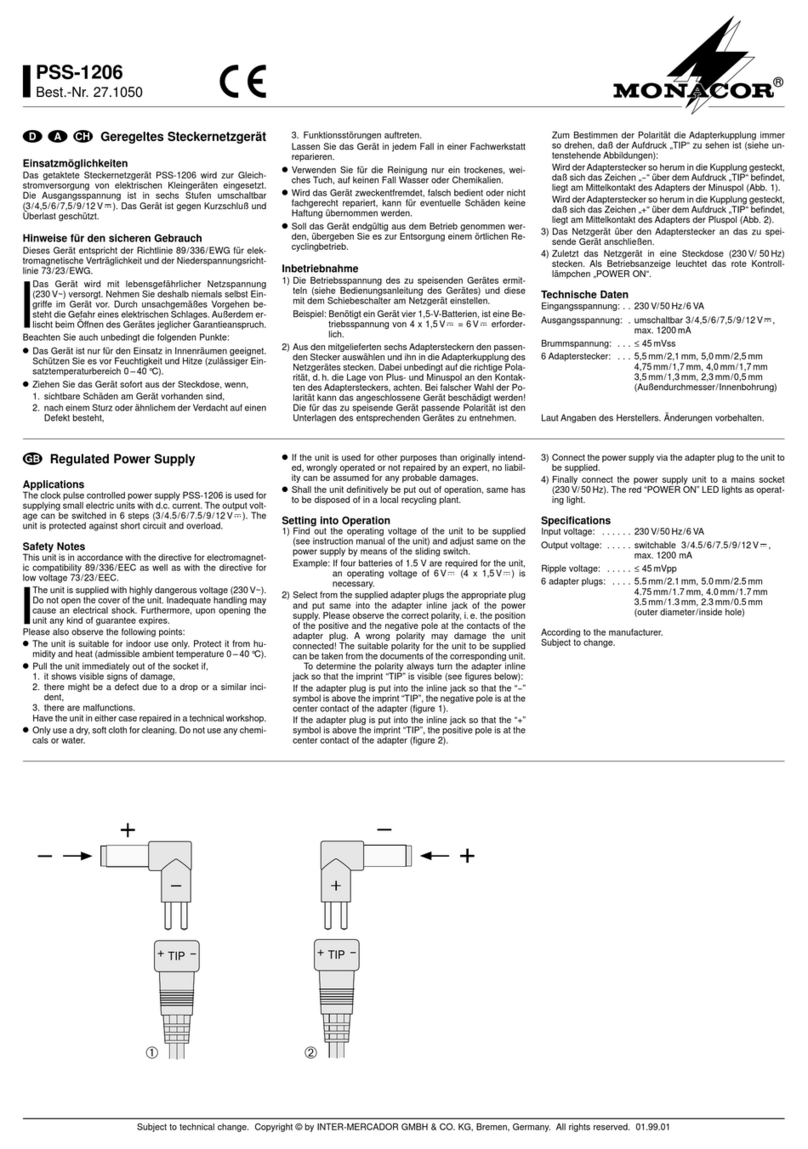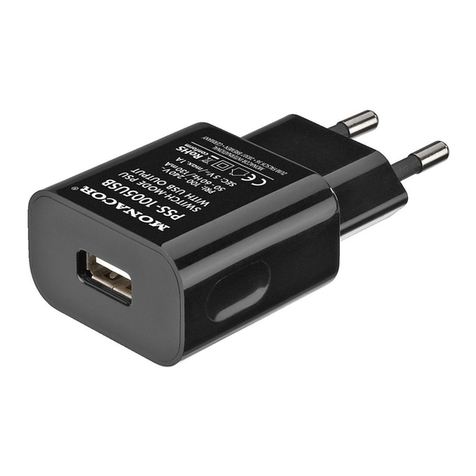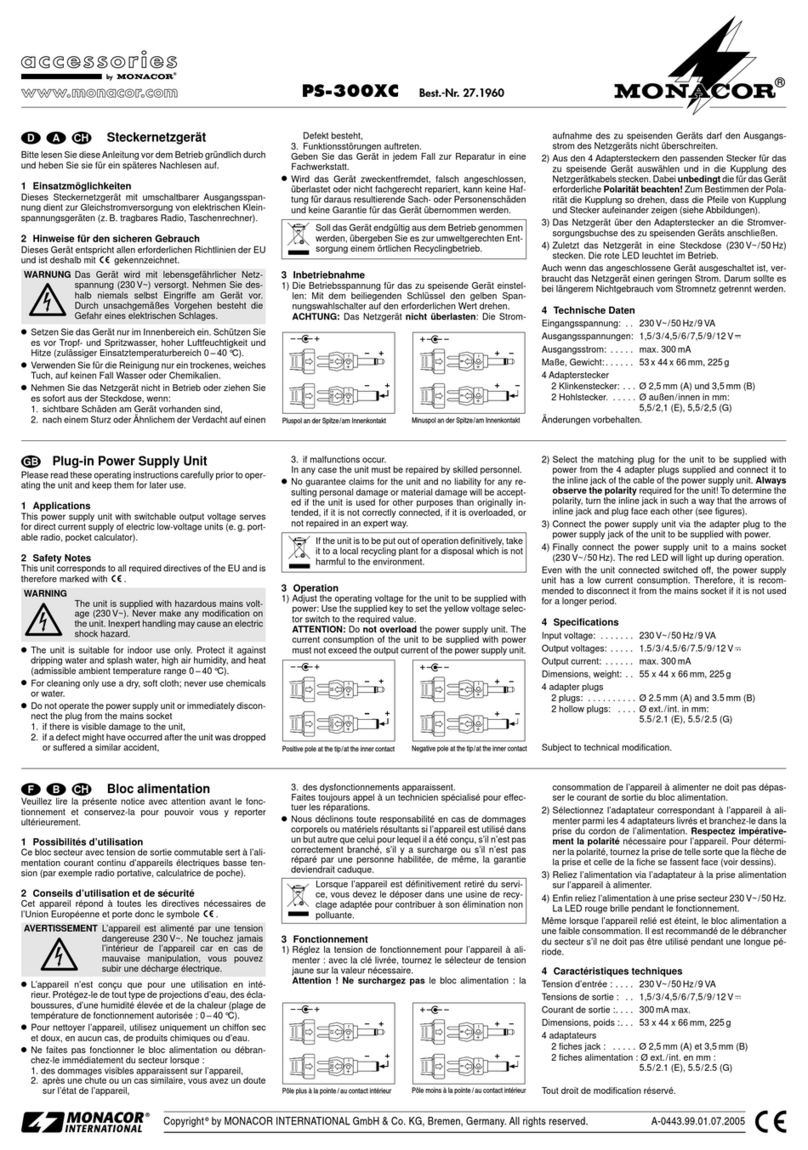Pluspol an der Spitze/am Innenkontakt Minuspol an der Spitze/am Innenkontakt
Alimentation à découpage
1 Possibilités d’utilisation
Cette alimentation à découpage avec tension de sortie com-
mutable sert à l’alimentation courant continu l‘appareils électri-
ques basse tension (p.ex. lecteur CD portable). Elle est
protégée contre les courts-circuits, surcharges et surchauffes.
2 Conseils d’utilisation et de sécurité
L’appareil répond à la norme européenne 89/336/CEE relative
à la compatibilité électromagnétique et à la norme européenne
73/23/CEE portant sur les appareils à basse tension.
●L’appareil n’est conçu que pour une utilisation en inté-
rieur. Protégez-le de tout type de projections d’eau, des écla-
boussures, d’une humidité élevée et de la chaleur (plage de
température de fonctionnement autorisée : 0–40°C).
●Ne faites pas fonctionner l’alimentation ou débranchez-la
immédiatement du secteur lorsque :
1. des dommages apparaissent sur l’appareil,
2. après une chute ou un cas similaire, vous avez un doute
sur l’état de l’appareil,
3. des dysfonctionnements apparaissent.
Faites toujours appel à un technicien spécialisé pour effec-
tuer les réparations.
Attention ! L’appareil est alimenté par une tension dange-
reuse. Ne touchez jamais l’intérieur de l’appareil car en cas
de mauvaise manipulation, vous pouvez subir une décharge
électrique.
●Pour nettoyer l’appareil, utilisez uniquement un chiffon sec
et doux, en aucun cas, de produits chimiques ou d’eau.
●Nous déclinons toute responsabilité en cas de dommages
corporels ou matériels résultants si l’appareil est utilisé dans
un but autre que celui pour lequel il a été conçu, s’il n’est pas
correctement branché, s’il y a surcharge ou s’il n’est pas
réparé par une personne habilitée, de même, la garantie
deviendrait caduque.
●Lorsque l’appareil est définitivement retiré du service, vous
devez le déposer dans une usine de recyclage adaptée pour
contribuer à son élimination non polluante.
3 Fonctionnement
1) Réglez la tension de fonctionnement pour l’appareil à basse
tension : avec la clé livrée, tournez le sélecteur de tension
jaune sur la valeur nécessaire.
La consommation de l’appareil basse tension ne doit pas
dépasserle courant desortie de l’alimentationpour la valeur
de tension réglée (voir tableau, chapitre 4) ;
2) Sélectionnez l’adaptateur correspondant à l’appareil basse
tension parmi les adaptateurs livrés et branchez-le dans la
prise du cordon de l’alimentation. Pour ce faire, respectez
impérativement la polarité nécessaire pour l’appareil basse
tension. Pour déterminer la polarité, tournez la prise de telle
sorte que la flèche de la prise et celle de la fiche se fassent
face (voir dessins).
3) Reliez l’alimentation via l’adaptateur à la connexion d’ali-
mentation sur l’appareil basse tension.
4) Enfin reliez l’alimentation à une prise secteur 100 –220V~/
50/60Hz.
Même lorsque l’appareil relié est éteint, l’alimentation a une fai-
bleconsommation. Il est recommandé dela débrancher du sec-
teur si elle ne doit pas être utilisée pendant une longue période.
4 Caractéristiques techniques
Tension d’entrée : . . 100–240V~, 50/60Hz, 40VA
Dimensions, poids : 35 x 50 x 85mm, 170g
7 adaptateurs
2 fiches jack : . . . Ø 2,5mm (A) et 3,5mm (B)
5 fiches
alimentation : . . . Ø ext./int. en mm : 2,35/0,75 (S),
3,5/1,35 (H), 5,0/2,1 (D), 5,5/2,1 (E),
5,5/2,5 (G)
D’après les données du constructeur.
Tout droit de modification réservé.
Switch Mode Power Supply Unit
1 Applications
This switch mode power supply unit with switchable output
voltage serves for direct current supply of electric low-voltage
units (e.g. portable CD player). The unit is short circuit-proof
and protected against overload and overheating.
2 Safety Notes
Theunitcorrespondstothedirectivefor electromagnetic compat-
ibility 89/336/EEC and to the low voltage directive 73/23/EEC.
●The unit is suitable for indoor use only. Protect it against
dripping water and splash water, high air humidity, and heat
(admissible ambient temperature range 0–40 °C).
●Do not operate the power supply unit or immediately dis-
connect it from the mains socket
1. if there is visible damage to the unit,
2. if a defect might have occurred after the unit was dropped
or suffered a similar accident,
3. if malfunctions occur.
In any case the unit must be repaired by skilled personnel.
●For cleaning only use a dry, soft cloth; never use chemicals
or water.
Attention! The unit is supplied with hazardous mains volt-
age. Leave servicing to skilled personnel only. Inexpert han-
dling may cause an electric shock hazard.
●No guarantee claims for the unit and no liability for any
resulting personal damage or material damage will be ac-
cepted if the unit is used for other purposes than originally
intended, if it is not correctly connected, if it is overloaded, or
not repaired in an expert way.
●If the unit is to be put out of operation definitively, take it to a
local recycling plant for a disposal which is not harmful to the
environment.
3 Operation
1) Adjustthe operating voltagefor the low-voltageunit: Use the
supplied key to set the yellow voltage selector switch to the
required value.
The current consumption of the low-voltage unit must not
exceed the output current of the power supply unit for the
voltage value adjusted (see table, chapter 4).
2) Select the matching plug for the low-voltage unit from the
adapter plugs supplied and connect it to the inline jack of the
cable of the power supply unit. In any case observe the
polarity required for the low-voltage unit. To determine the
polarity, turn the inline jack in such a way that the arrows of
inline jack and plug face each other (see figures).
3) Connect the power supply unit via the adapter plug to the
power supply jack of the low-voltage unit.
4) Finally connect the power supply unit to a mains socket
(100–240V~, 50/60Hz).
Even with the unit connected switched off, the power supply
unit has a low current consumption. Therefore, it is recom-
mended to disconnect it from the mains socket if it is not used
for a longer period.
4 Specifications
Input voltage: . . . . . 100–240V~, 50/60Hz, 40VA
Dimensions, weight: 35 x 50 x 85mm, 170g
7 adapter plugs
2 plugs: . . . . . . . . Ø 2.5mm (A) and 3.5mm (B)
5 hollow plugs: . . Ø ext./int. in mm:
2.35/0.75 (S), 3.5/1.35 (H), 5.0/2.1 (D),
5.5/2.1 (E); 5.5/2.5 (G)
Accordingto the manufacturer.Subject to technicalmodification.
GB
Schaltnetzgerät
1 Einsatzmöglichkeiten
Dieses Schaltnetzgerät mit umschaltbarerAusgangsspannung
dient zur Gleichstromversorgung von elektrischen Kleinspan-
nungsgeräten (z.B. tragbarer CD-Player). Es ist kurzschluss-
fest und gegen Überlast und Überhitzung geschützt.
2 Hinweise für den sicheren Gebrauch
Das Gerät entspricht der Richtlinie für elektromagnetische Ver-
träglichkeit 89/336/EWG und der Niederspannungsrichtlinie
73/23/EWG.
●Verwenden Sie das Gerät nur im Innenbereich. Schützen
Sie es vor Tropf- und Spritzwasser, hoher Luftfeuchtigkeit
und Hitze (zulässiger Einsatztemperaturbereich 0–40°C).
●Nehmen Sie das Netzgerät nicht in Betrieb bzw. ziehen Sie
es sofort aus der Steckdose, wenn:
1. sichtbare Schäden am Gerät vorhanden sind,
2. nach einem Sturz oder Ähnlichem der Verdacht auf einen
Defekt besteht,
3. Funktionsstörungen auftreten.
Geben Sie das Gerät in jedem Fall zur Reparatur in eine
Fachwerkstatt.
Achtung! Das Gerät wird mit lebensgefährlicher Netzspan-
nung versorgt. Nehmen Sie deshalb niemals selbst Eingriffe
im Gerät vor. Durch unsachgemäßes Vorgehen besteht die
Gefahr eines elektrischen Schlages.
●Verwenden Sie für die Reinigung nur ein trockenes, weiches
Tuch, auf keinen Fall Wasser oder Chemikalien.
●Wird das Gerät zweckentfremdet, falsch angeschlossen,
überlastet oder nicht fachgerecht repariert, kann keine Haf-
tung für daraus resultierende Sach- oder Personenschäden
und keine Garantie für das Gerät übernommen werden.
●Soll das Gerät endgültig aus dem Betrieb genommen wer-
den, übergeben Sie es zur umweltgerechten Entsorgung
einem örtlichen Recyclingbetrieb.
3 Inbetriebnahme
1) Die Betriebsspannung für das Kleinspannungsgerät einstel-
len: Mit dem beiliegenden Schlüssel den gelben Span-
nungswahlschalter auf den erforderlichen Wert drehen.
Die Stromaufnahme des Kleinspannungsgeräts darf den
Ausgangsstrom des Netzgeräts für den eingestellten Span-
nungswert (siehe Tabelle, Kap. 4) nicht überschreiten.
2) Aus den beiliegenden Adaptersteckern den für das Klein-
spannungsgerät passenden auswählen und in die Kupplung
des Netzgerätkabels stecken. Dabei unbedingt die für das
Kleinspannungsgerät erforderliche Polarität beachten.
Zum Bestimmen der Polarität die Kupplung so drehen, dass
die Pfeile von Kupplung und Stecker aufeinander zeigen
(siehe Abbildungen).
3) Das Netzgerät über den Adapterstecker an die Stromver-
sorgungsbuchse des Kleinspannungsgeräts anschließen.
4) Zuletzt das Netzgerät in eine Steckdose (100–240V~,
50/60Hz) stecken.
Auch wenn das angeschlossene Gerät ausgeschaltet ist, ver-
braucht das Netzgerät einen geringen Strom. Darum sollte es
bei längerem Nichtgebrauch vom Stromnetz getrennt werden.
4 Technische Daten
Eingangsspannung: 100–240V~, 50/60Hz, 40VA
Maße, Gewicht: . . . 35x 50x 85mm, 170g
7 Adapterstecker: . .
2 Klinkenstecker: Ø 2,5mm (A) und 3,5mm (B)
5 Hohlstecker. . . . Ø außen/innen in mm: 2,35/0,75 (S),
3,5/1,35 (H), 5,0/2,1 (D), 5,5/2,1 (E),
5,5/2,5 (G)
Laut Angaben des Herstellers. Änderungen vorbehalten.
PSS-800 Best.-Nr. 27.1820
